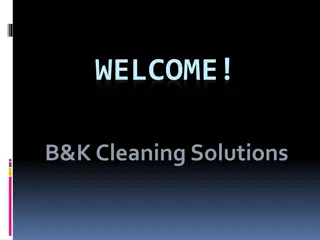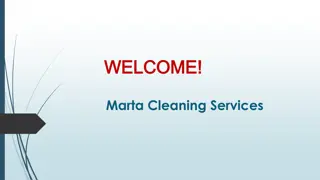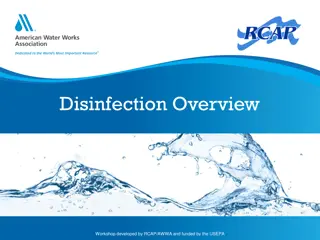Best Practices for Environmental Cleaning and Disinfection in Healthcare Settings
Effective environmental cleaning and disinfection are crucial in reducing healthcare-associated infections, especially in the context of COVID-19. This webinar by Dr. Lata Kapoor emphasizes the importance of cleaning high-touch surfaces and implementing established cleaning strategies to remove bioburden and disinfect equipment and environmental surfaces. Key principles include minimizing pathogen transmission through hand hygiene, using antimicrobial agents effective against coronaviruses, and prioritizing the cleaning of surfaces with frequent hand contact in patient-care areas.
Download Presentation

Please find below an Image/Link to download the presentation.
The content on the website is provided AS IS for your information and personal use only. It may not be sold, licensed, or shared on other websites without obtaining consent from the author.If you encounter any issues during the download, it is possible that the publisher has removed the file from their server.
You are allowed to download the files provided on this website for personal or commercial use, subject to the condition that they are used lawfully. All files are the property of their respective owners.
The content on the website is provided AS IS for your information and personal use only. It may not be sold, licensed, or shared on other websites without obtaining consent from the author.
E N D
Presentation Transcript
IPC Webinar Environmental cleaning and Environmental cleaning and disinfection disinfection Dr Lata Kapoor Joint Director National Centre for Disease Control Govt. of India Strengthening Infection Prevention & Control for COVID-19 in Healthcare Facilities focus on Private Sector | 4 May 2020
Outline Outline Environmental cleaning and Disinfection Environmental decontamination Cleaning of medical equipment Cleaning soiled bedding, towels and clothes from patients with COVID-19 Cleaning and disinfection of occupied patient rooms Cleaning and disinfection after patient discharge and transfer Prevent environment contamination: contain respiratory secretions
Environmental Decontamination (1) Environmental Decontamination (1) General Principles Healthcare environment contains a diverse population of microorganisms, but only few are significant pathogens Microbiologically contaminated surfaces can serve as reservoirs of potential pathogens Contaminated surfaces not directly associated with transmission of infections to either staff or patients Transfer of microorganisms from environmental surfaces to patients is mostly via hand contact with the surface Hand hygiene is important to minimize the impact of this transfer Cleaning and disinfecting environmental surfaces is fundamental in reducing healthcare-associated infections
Environmental Decontamination (2) Environmental Decontamination (2) COVID-19 virus can potentially survive in the environment for several hours/days Premises and areas potentially contaminated with the virus to be cleaned before their re-use Products containing antimicrobial agents known to be effective against coronaviruses may be used Established cleaning strategies to be used Remove the majority of bioburden Disinfect equipment and environmental surfaces
Environmental Decontamination (3) Environmental Decontamination (3) Housekeeping surfaces can be divided into two groups Those with minimal hand contact (e.g. floors and ceilings) High touch surfaces those with frequent hand-contact High touch housekeeping surfaces in patient-care areas should be cleaned and/or disinfected more frequently Doorknobs Bedrails Light switches Wall areas around the toilet in the patient s room Edges of privacy curtains
Cleaning and disinfection of medical Cleaning and disinfection of medical equipment (1) equipment (1) Wear gloves when handling/transporting used patient care equipment Before removing equipment from patients room, medical equipment must be disinfected Non-critical medical equipment Usually only require cleansing followed by low- to intermediate-level disinfection, depending on the nature and degree of contamination E.g. stethoscopes, blood pressure cuffs, dialysis machines and equipment knobs and controls
Cleaning and disinfection of medical Cleaning and disinfection of medical equipment (2) equipment (2) In absence of manufacturer instructions regarding cleaning/disinfection of equipment Ethyl alcohol or isopropyl alcohol (70%, v/v) often used to disinfect small surfaces (rubber stoppers of multiple-dose medication vials, and thermometers) and occasionally external surfaces of equipment (stethoscopes and ventilators) Alcohol causes discoloration, swelling, hardening and cracking of rubber and certain plastics after prolonged and repeated use
Cleaning and disinfection of medical Cleaning and disinfection of medical equipment (3) equipment (3) Difficult to clean surfaces and equipment Barrier protection of difficult to clean surfaces and equipment is useful, especially if these surfaces are Touched frequently by gloved hands during the delivery of patient care Likely to become contaminated with body substances Impervious-backed paper, plastic or fluid-resistant covers are suitable for use as barrier protection (cover mattresses for easier disinfection) Remove and discard/disinfect coverings with gloved hands Perform hand hygiene after ungloving Cover these surfaces with clean materials before the next patient encounter
Cleaning and disinfection of medical Cleaning and disinfection of medical equipment (4) equipment (4) Area/Items Inputs Process Method/ procedure Stethoscope Alcohol-based rub/Spirit swab Cleaning o Should be cleaned with detergent and water regularly o Should be wiped with alcohol based rub/spirit swab before each patient contact BP cuffs & covers Detergent Hot water Washing o Cuffs should be wiped with alcohol- based disinfectant and regular laundering is recommended for the cover Thermometer Detergent and water Alcohol rub Individual thermometer holder Cleaning o Should be stored dry in individual holder, inverted o Clean with detergent and tepid water and wipe with alcohol rub in between patient use o Preferably one thermometer for each patient Injection and dressing trolley Detergent and water Duster Disinfectant (70% alcohol) Cleaning o To be cleaned daily with detergent and water o After each use should be wiped with disinfectant
Cleaning soiled bedding, towels and clothes Cleaning soiled bedding, towels and clothes from patients with COVID from patients with COVID- -19 (1) 19 (1) Clean laundry and surfaces in all environments in which COVID-19 cases receive care at least once a day and when a patient is discharged Hospital disinfectants: 70% alcohol for small areas reusable dedicated equipment (e.g. thermometers) Sodium hypochlorite at 1% for surface disinfection Staff dealing with soiled bedding, towels and clothes from patients with COVID-19 should: Wear appropriate PPE heavy duty gloves, mask, eye protection (goggles/face shield), long- sleeved gown, apron (if gown is not fluid resistant), and boots or closed shoes Never carry soiled linen against body; place soiled linen in a leak-proof bag or bucket Perform hand hygiene after blood/body fluid exposure and after PPE removal
Cleaning soiled bedding, towels and clothes Cleaning soiled bedding, towels and clothes from patients with COVID from patients with COVID- -19 (2) 19 (2) Soiled linen should be placed in clearly labelled, leak-proof bags or containers, carefully removing any solid excrement and putting in covered bucket to dispose of in the toilet Washing machine Wash at 60-90 C with laundry detergent followed by soaking in 0.01% chlorine for approximately 30 minutes and dried No machine washing Soaked in hot water with soap/detergent in a large drum Use a stick to stir and avoid splashing Empty the drum and soak linen in 0.01% chlorine for approx. 30 minutes Rinse with clean water and let linens dry fully in the sunlight
Cleaning and disinfection of occupied patient Cleaning and disinfection of occupied patient rooms rooms Designate specific well-trained staff for cleaning environmental surfaces Cleaning personnel should wear PPE and must be trained on proper use of PPE and hand hygiene Define the scope of cleaning to be done each day Use a checklist to promote accountability for cleaning responsibilities Keep cleaning supplies outside the patient room
Cleaning of Housekeeping surfaces and eating Cleaning of Housekeeping surfaces and eating utensils utensils Housekeeping surfaces: Regularly clean and remove soil and dust Personal protective equipment (PPE) to be used during cleaning and housekeeping procedures Clean only with soap and water or a detergent/disinfectant, depending on the nature of the surface and the degree of contamination Dishes and eating utensils used by a patient with known or suspected infection No special precautions other than standard precautions Wear gloves when handling patient trays, dishes and utensils
Spill management Spill management Worker assigned to clean the spill should wear gloves and other personal protective equipment Most of the organic matter of the spill to be removed with absorbent material Surface to be cleaned to remove residual organic matter Use disinfectant: hypochlorite 1% for small spills 10% for large spills
Cleaning and disinfection after patient Cleaning and disinfection after patient discharge or transfer discharge or transfer Clean and disinfect all surfaces that were in contact with patient or may have become contaminated during patient care Do not spray or fog occupied or unoccupied rooms with disinfectant potentially dangerous practice that has no proven benefits
Prevent environment contamination: contain Prevent environment contamination: contain respiratory secretions (1) respiratory secretions (1) Ensure early recognition and prevention of transmission of the respiratory virus at the initial encounter with a healthcare setting Practice respiratory hygiene/cough etiquette Ensure availability of materials for adhering to respiratory hygiene/cough etiquette in waiting areas for patients and visitors Masking and separation of persons with symptoms of respiratory infection/Universal masking
Summary Summary Cleaning and disinfecting environmental surfaces is fundamental in reducing healthcare-associated infections Established cleaning strategies to be used, rigorously monitored Cleaning staff must be protected by use of standard precautions including use of appropriate PPE Prevent environment contamination by containing respiratory secretions
Thank you Thank you























